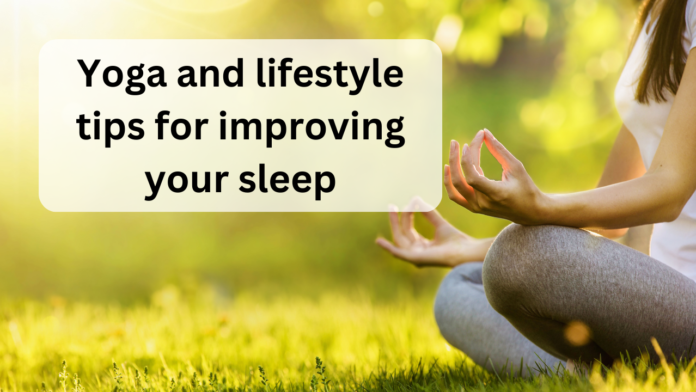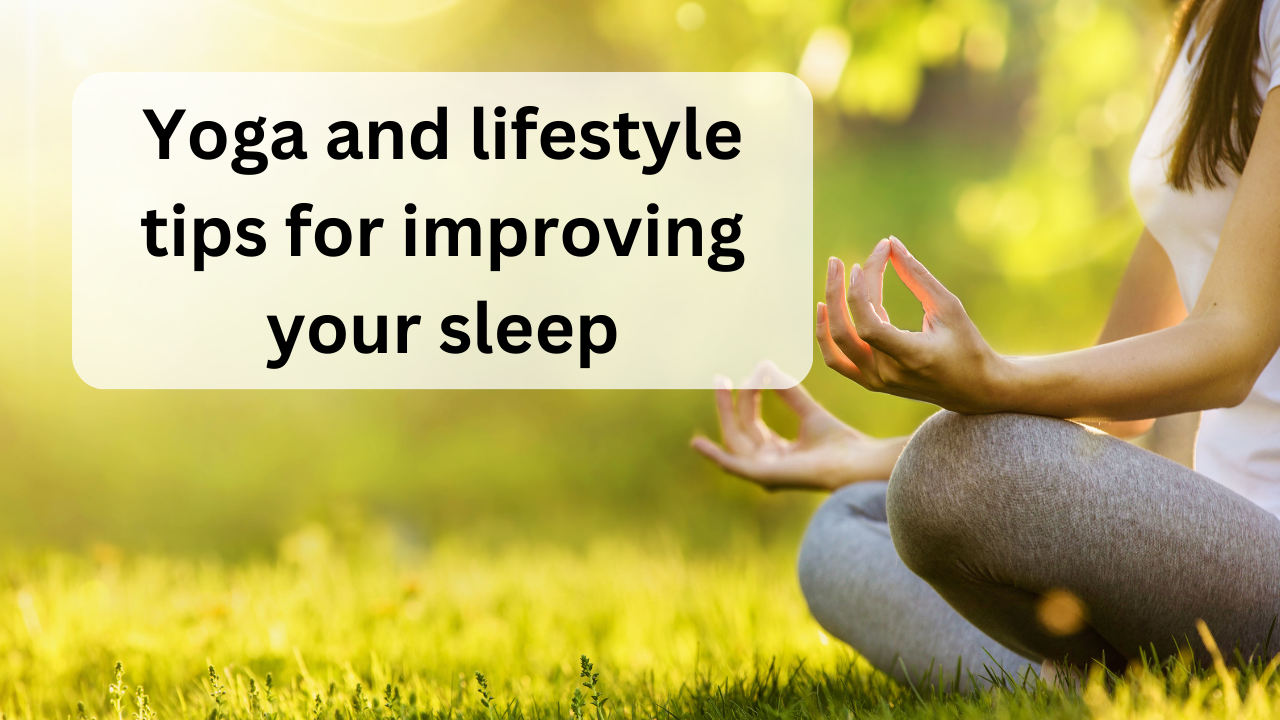In the whirlwind of our daily lives, finding a peaceful night’s sleep can be a challenge. But fear not – the ancient practice of yoga holds the key to better sleep! In this guide, we’ll explore simple and effective yoga and lifestyle tips to improve your sleep. From sleep-enhancing yoga poses to understanding the importance of sleep cycles, we’ll delve into the holistic approach that combines the wisdom of yoga with practical lifestyle adjustments.
What is sleep, and why is it important?
Sleep is a fundamental aspect of human existence, yet its complexity has puzzled scientists, philosophers, and individuals alike for centuries. What exactly is sleep, and why is it so crucial to our well-being? As we delve into the realms of neuroscience, psychology, and physiology, we begin to unravel the intricate tapestry that is the world of sleep.
At its core, sleep is a naturally recurring state of altered consciousness, characterized by reduced sensory activity and inhibited voluntary muscle movements. It is a dynamic and highly organized process that unfolds in distinct stages, each serving a unique purpose in maintaining overall health and functionality.
What happens when we get poor sleep?
Poor sleep, whether due to insufficient duration, interrupted sleep, or low sleep quality, can have profound consequences on various aspects of our physical and mental well-being. The effects of inadequate sleep extend beyond a simple feeling of tiredness and can impact multiple facets of daily life. Here are some key consequences of poor sleep:
Cognitive Impairment:
- Memory and Learning: Sleep plays a crucial role in memory consolidation. Poor sleep can affect the ability to learn new information and retain memories.
- Attention and Concentration: Lack of sleep is associated with decreased focus, attention lapses, and difficulty concentrating on tasks.
Mood Disturbances:
- Irritability: Sleep deprivation often leads to irritability and mood swings.
- Increased Stress: The body’s stress response is heightened when sleep is inadequate, contributing to elevated cortisol levels.
Weakened Immune Function:
- Chronic sleep deprivation suppresses the immune system, making the body more susceptible to infections and illnesses.
- Reduced production of cytokines, essential for immune response, occurs with inadequate sleep.
Metabolic Consequences:
- Weight Gain: Poor sleep is associated with changes in appetite-regulating hormones, leading to increased hunger and a higher likelihood of weight gain.
- Insulin Resistance: Sleep deprivation can contribute to insulin resistance, a precursor to diabetes.
Cardiovascular Risks:
- Chronic sleep deprivation is linked to an increased risk of cardiovascular diseases, including hypertension and heart attacks.
- Disruptions in sleep patterns can negatively impact blood pressure regulation.
Impaired Physical Performance:
- Athletes and individuals engaged in physical activities may experience a decline in performance due to decreased coordination, slower reaction times, and reduced endurance.
Mental Health Issues:
- Anxiety and Depression: Poor sleep is closely associated with an increased risk of anxiety and depression. Sleep disturbances can exacerbate existing mental health conditions.
- Emotional Regulation: Sleep is crucial for emotional resilience, and insufficient sleep can lead to heightened emotional responses.
Increased Risk of Accidents:
- Impaired alertness and slower reaction times increase the risk of accidents, both on the road and in daily activities.
Hormonal Imbalances:
- Disruptions in sleep can affect the release of hormones, including growth hormone and testosterone.
- Menstrual irregularities may occur in women with poor sleep patterns.
The 4 sleep cycles
Sleep is a dynamic and organized process that unfolds in a series of distinct cycles, each characterized by specific stages and functions. The sleep cycles alternate between Non-Rapid Eye Movement sleep(NREM) and Rapid Eye Movement (REM) sleep, creating a rhythmic pattern throughout the night. Here’s a breakdown of the four sleep cycles:
NREM1 Sleep (Non-Rapid Eye Movement Stage 1): 1-5 minutes
- NREM1 marks the transition from wakefulness to sleep.
- It is a brief period lasting only a few minutes, where the body begins to relax, and the individual may experience drifting thoughts.
- Muscle activity decreases, and eye movements are slow and may include occasional twitches.
NREM2 Sleep: 10-60 minutes
- NREM2 is a slightly deeper stage of sleep.
- It constitutes a significant portion of the overall sleep cycle.
- During NREM2, eye movements cease, heart rate slows, and body temperature decreases.
- Sleep spindles (short bursts of brain activity) and K-complexes (large, slow brain waves) may occur, playing a role in protecting the sleep state.
NREM3 Sleep: 20-40 minutes
- NREM3, also known as slow-wave sleep (SWS) or deep sleep, is characterized by slow brain waves, and it is the stage where physical restoration and repair occur.
- Growth hormone is released during this stage, contributing to the repair and growth of tissues and muscles.
- It is more challenging to be awakened during NREM3, and if awakened, individuals may feel groggy or disoriented.
REM Sleep: 10-60 minutes
- REM sleep is the stage associated with vivid dreaming.
- Despite the name “Rapid Eye Movement,” eye movements are quick and dart in various directions.
- Brain activity during REM sleep is similar to wakefulness, and this is when most dreaming occurs.
- REM sleep is crucial for cognitive functions, memory consolidation, and emotional processing.
- Muscles become temporarily paralyzed, preventing individuals from acting out their dreams.
4 ways to improve your sleep
Manage Light Exposure:
- Morning Exposure to Natural Light: Exposure to natural light in the morning helps regulate your body’s internal clock (circadian rhythm). Aim to spend time outdoors or open your curtains to let in natural light shortly after waking up. This helps signal to your body that it’s time to be alert and awake.
- Limit Evening Light Exposure: In the evening, reduce exposure to bright lights, especially those from screens such as phones, tablets, and computers. The blue light emitted from these devices can suppress melatonin production, making it harder for you to fall asleep.
Relax and De-stress:
- Create a Bedtime Routine: Establish a calming routine before bedtime to signal to your body that it’s time to wind down. This may include activities such as reading a book, taking a warm bath, or practicing relaxation techniques.
- Mindfulness and Breathing Exercises: Engage in mindfulness or deep-breathing exercises to calm your nervous system. Techniques such as progressive muscle relaxation or guided imagery can help reduce stress and anxiety, promoting a more restful sleep.
Yoga for Better Sleep:
- Gentle Yoga Poses: Incorporate gentle yoga postures into your evening routine. Poses that focus on relaxation and stretching, such as child’s pose, forward bends, or legs-up-the-wall pose, can help release tension and prepare your body for sleep.
- Mindful Movement: Practices like yoga not only promote physical relaxation but also encourage mental relaxation. Combining movement with focused breathing helps quiet the mind, making it easier to transition into a peaceful sleep.
Create a Comfortable Sleep Environment:
- Maintain a Cool Temperature: Keep your bedroom cool, ideally between 60-67 degrees Fahrenheit (15-20 degrees Celsius). A cooler environment is often more conducive to sleep.
- Invest in Comfortable Bedding: Ensure your mattress and pillows are comfortable and supportive. The right bedding can make a significant difference in your overall sleep quality.
- Minimize Noise and Light: Use blackout curtains or an eye mask to block out light, and consider using earplugs or white noise machines to minimize disruptive sounds.
Incorporating these practices into your daily routine can contribute to better sleep hygiene and foster a conducive sleep environment. It’s important to recognize that individual preferences may vary, so finding a combination of strategies that work best for you is key to establishing healthy sleep habits.
Conclusion:
Yoga, with its gentle poses, mindful movement, and focus on relaxation, emerges as a powerful ally in promoting better sleep. The incorporation of yoga into bedtime routines not only facilitates physical relaxation but also encourages mental calmness, creating an ideal transition into a peaceful night’s sleep.
Moreover, the holistic lifestyle adjustments recommended, such as managing light exposure and creating a comfortable sleep environment, seamlessly align with the principles emphasized in yoga teacher training course. The nurturing of mindfulness, stress reduction techniques, and the understanding of one’s unique sleep needs are all integral components of the yogic philosophy.
By embracing the teachings of yoga, not only do individuals enhance their own well-being, but they also become equipped to guide others on a similar journey towards holistic health and balanced living. In essence, the pursuit of better sleep becomes a shared endeavor, rooted in the ancient wisdom imparted by yoga and further amplified through the knowledge gained in a yoga teacher training course in Pune


